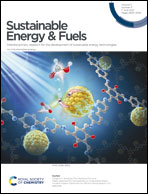Nitrogen-rich covalent organic polymers and potassium iodide for efficient chemical fixation of CO2 into epoxides under mild conditions†
Abstract
Resource utilization of carbon dioxide (CO2) to add value to the chemicals used in the preparation of cyclic carbonates has gained significant interest in sustainable chemistry and environmental preservation. Herein, new nitrogen-rich urea covalent organic polymers (NUP-1, NUP-2, NUP-3) with multiple urea groups simultaneously acting as acidic nodes were designed and synthesized in a simple method. These synthesized NUPs were characterized using FT-IR spectroscopy, 13C CP MAS NMR, SEM, PXRD, TGA, XPS spectroscopy, CO2 adsorption and nitrogen adsorption–desorption. The novel NUP-3 catalyst was particularly effective in the cycloaddition reactions having obtained a 93% yield of cyclic carbonate after 24 h at 90 °C with 0.1 MPa of pressure, using 1.0 mol% of KI and 70 mg of NUP-3. The results showed that the functionalized NUP-3 used as a catalyst for the cycloaddition reaction of CO2 and epoxide with an alkali-metal salt, exhibited good activity under mild conditions. In addition, a mechanistic insight into the effects of urea groups on the activation of both epoxide and CO2 was gained using DFT calculations.



 Please wait while we load your content...
Please wait while we load your content...